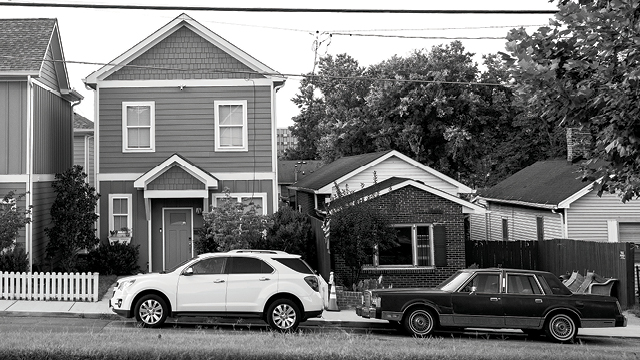It was only a matter of time before Nashville’s explosive growth finally reached its northern zone. But with expansive redevelopment occurring seemingly on every piece of vacant land, questions pop up like rooftops.
Who wins and who loses with housing demands and rents both steadily rising? Where are the communities with the most to gain? What are the roles and responsibilities of public officials and developers and when does Nashville’s runaway real estate train slow down?
The impressive mixed-use apartment complexes and tall skinny single-family homes, along with added commercial services and amenities, have transformed older Nashville neighborhoods such as East Nashville, 12 South and The Nations. With that came greater property values, higher taxes and rents, and most importantly, new neighbors. The juxtaposition of bright shiny new structures next to dated, rundown old ones has created some uneasiness about residents being displaced and the shape of things to come. And nowhere is that more noticeable than in the communities of North Nashville.
It should be pointed out there isn’t a single, cohesive North Nashville. Rather, there are many smaller pockets stretching from Charlotte Avenue and Interstate 440 to Rosa Parks Boulevard and Jefferson Street and from MetroCenter back to Tennessee State University.
In those pockets, developers have been getting plenty of attention and, at times, just as much criticism from people saying they are taking advantage of a neighborhood that is on the whole still cheaper than most of the rest of Nashville.
“People make developers out to be the bad guys, but nobody does anything without going through the proper channels,” says John Eldridge III, who heads E3 Construction Services, a company that is helping transform the area around McKissack Park with several residential projects, including 27N. at City Heights, The Cottages, Twenty Five 07and the Summit at City Heights, as well as various single-family homes.
“We are not bullying anybody; we host community meetings to hear from everyone,” he says. “We’ve gone a long way to make this work — especially with cost-effective workforce housing.”
Within the general McKissack Park area, which E3 has christened City Heights, Eldridge owns an upwards of 50 properties that could, via their zoning, accommodate about 300 residential units.
However, longtime North Nashville business owner Rosetta Miller-Perry thinks Eldridge is forcing people out of the area when “all the small homes in McKissack Park are going to be gone,” and anyone wanting to stay will be priced out.
“It’s all about development and money. All the vacant lots are being bought and these tall skinnies are going up. Once they are built, the itty-bitty taxes folks over there are paying are going to go up,” says Perry, who also is founder and publisher of The Tennessee Tribune. “They can build all the nice apartments they want and set rents at $1,200 to $1,500 — who can afford that? I can’t.”
Lee Molette, a Nashville developer and financial advisor, thinks the notion that developers are evildoers is wrong, and defends the work Eldridge is doing in trying to create something sustainable and profitable from abandoned properties.
The lots weren’t made vacant by developers, Eldridge and Molette says. They view abandoned properties as a sign of the times.
“It’s the demand of the city,” Molette says about his work building housing for Nashville’s population growth. “People accuse folks like me of stealing land, but that’s not the case. If you want to see development, everybody’s got to win. And the developers are the ones that have all the risk — front-end money, architectural fees, permits, everything to get the property titled.
“We have to get everything ready before a dime gets made,” he adds. “In all fairness, we should make a profit at some point. But people are not focused on that.”
Plans versus urgency
The issues people focus on in North Nashville changes with each individual. In the years it has taken for Nashville’s redevelopment wave to make its way to parts of North Nashville, different opinions, desires and wishlists have been created. Even Perry, who founded the Greater Nashville Black Chamber of Commerce, sees a double-edged sword in that tension.
“It’s both a blessing and a curse that growth didn’t come to North Nashville until recently,” she says. “Growth has to occur and you can’t have a ghetto forever. But I think it could have been planned a little better.”
With the acceleration of the city’s growth, especially in the urban core, plans may be getting supplanted by urgency. Molette believes land prices and construction costs will continue to rise substantially, and with so many proposals in the works simultaneously, every minute counts in order to make projects’ finances work.
Complicating matters, he says, is that smaller developers often are having to jump through more hoops than some of the bigger developers and getting meeting times with Metro government officials can be difficult. That can delay projects or stifle them altogether and many of Mollette’s projects focus on one parcel at a time.
Metro City Councilman Freddie O’Connell, whose District 19 includes the North Nashville enclaves of Germantown, Salemtown and Historic Buena Vista, has been besieged with rezoning or redevelopment proposals since taking office four years ago. (O’Connell was re-elected to another term on Aug. 1.)
“It’s ceaseless. It’s been four years nonstop,” says the councilman of the paperwork crossing his desk. “But I will say, I want it. A vacant lot is one of the worst things I can go look at. I want to see the infill. I want to see appropriate density.”
A number of larger redevelopment projects are clearly visible now on the north side. Some of the most heralded ones are Hope Gardens, Werthan Lofts, LC Germantown and now City Heights. Prices, whether renting or owning, can vary widely — recent Hope Gardens home listings have ranged from $170,000 to $799,000 — but many places such as Werthan regularly command $2,000 monthly rents. Then again, the Lofts offer a regulation Bocce ball court, an award-winning saltwater pool and a fitness center while LC, from Lifestyle Communities, has an alley that winds through the complex to hidden garages and is just steps from Cumberland River Greenway.
O’Connell knows that his district’s amenities, such as the greenway, First Tennessee Park and the proximity to downtown, have made it easier for developers, businesses and new residents to establish what’s become a vibrant community right next to the Jefferson Street corridor considered one of the centers of North Nashville’s African-American history. But he thinks it can work anywhere with the right people in place.
“I want the growth to be as good as we can get it. I wouldn’t want this to be on autopilot. My role is to ask, ‘Can we make it fit the community preferences better, make it include some piece of affordability, make it sustainable?’ Can we hit on any of these moments?”
Several parts of the area — many of them the predominantly black neighborhoods generally assigned as “North Nashville” — aren’t seeing those types of development. And they may not see projects of the type being built in Salemtown or Hope Gardens for a long time.
Once a thriving hub of Nashville’s African American community, the area along Jefferson Street was a mecca for blues and jazz until the 1950s — construction of Interstate 40 tore through the core of the district — and is home to several historically black universities. However, the area has suffered from a disproportionate share of the city’s crime and poverty, and properties deteriorated or abandoned.
“You don’t see the number of apartment buildings in North Nashville that you see in Germantown,” Molette says. “Mostly what you see there are being sold as short-term rentals.”
He thinks this is an area perhaps where government can play a role. The $750 million affordable housing plan presented by Mayor David Briley, is a first “actionable step to address it,” says Molette.
Briley announced in March that nearly half the money he is setting aside will help pay for 5,000 low- and middle-income homes, primarily through the redevelopment of aging public housing communities. With the “Under One Roof 2029” plan, he wants to see the city build 10,000 affordable housing units over the next decade. By most standards, an affordable home is where no more than 30 percent of monthly income is spent on housing.
Metro’s investment, according to the initiative, could result in about 5,000 new units — and 20 percent of them would be dedicated to extremely low-income individuals.
Still, bigger developers aren’t working on affordable housing. Instead, they focus on high-profile projects such as hotels, according to Molette, who added, “If we had a way to include workforce housing in a development, we would work with the city to make that happen.”
A next step: Commercial uses
For his part, Eldridge has attempted to build affordable units in North Nashville. He points to The Vibe at Marathon Village, a 67-unit gated apartment community E3 built in 2017 in the 1600 block of Herman Street, near Fisk University.
“Workforce housing is tough, but we built the Vibe as affordable rentals, offering reduced rents — around 20 to 30 percent less than downtown apartments,” says Eldridge. “We were 100 percent leased out 15 days after making that decision.”
It is apparent that wherever he builds now, there is no shortage of people ready to move in. The demand for living in these neighborhoods is there.
Eldridge is incredulous that other developers didn’t beat him to the McKissack Park area, which features views of the city’s core and is close to hospitals and universities. After meeting with community leaders as he shaped his plans, he moved E3’s offices to the intersection of Clifton Avenue and 28th Avenue North, at the heart of the district. His team’s home is across the street from Swett’s Restaurant, the community’s cornerstone.
Eldridge says he wanted to show the community that he “was all in” and called his decision “the right move.” David Swett, who has owned the iconic restaurant since 1954, has supported Eldridge and E3’s work in revitalizing the area, helping to host community meetings and offering some history and perspective.
“What these developers are doing isn’t at all a bad idea,” Swett says. “It brings more people in the community, more residential here, and it upgrades and makes the community a better place to live.”
In time, the density being added may also bring needed commercial ventures such as grocery stores or banks. Other than the Kroger supermarket at Rosa Parks Boulevard and Monroe Street, residents of all these new developments still need to travel several miles to buy groceries. (A Publix store is being built at the Capitol View development on the edge of downtown.)
Banks are scant as well. Along Jefferson and Buchanan streets from downtown to TSU, there are just two, one of them the long-standing Citizens Savings Bank & Trust, the nation’s oldest continuously operating minority-owned lender.
Molette is hoping that the commercial growth in MetroCenter eventually will spread back toward some of North Nashville’s smaller communities. He points to several hotels being built and the large number of apartments going up but acknowledges that it is “a long way to travel” for many people.
While North Nashville redevelopment is just getting started, Eldridge says he sees revitalized and successful communities from these shared efforts.
“We have been successful and welcomed into the communities where we are building because we are establishing credibility, and earning a reputation based on trust,” Eldridge says. “The type of developments we are doing pays back dividends that you can’t see on a balance sheet.”


